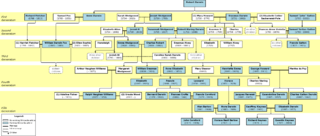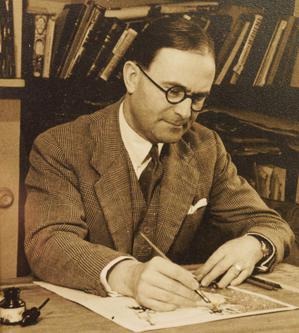
The Darwin–Wedgwood family are members of two connected families, each noted for particular prominent 18th-century figures: Erasmus Darwin, a physician and natural philosopher, and Josiah Wedgwood FRS, a noted potter and founder of the eponymous Josiah Wedgwood & Sons pottery company. The Darwin and Wedgwood families were on friendly terms for much of their history and members intermarried, notably Charles Darwin, who married Emma Wedgwood.

Brigadier-General Paul Aloysius Kenna, VC, DSO was an English-born British Army officer of Irish descent and recipient of the Victoria Cross (VC), the highest and most prestigious award for gallantry in the face of the enemy that could be awarded to British and British Empire forces. He also competed at the 1912 Summer Olympics.

Charles Manigault Morris was an officer in the United States Navy and later in the Confederate States Navy. Morris was a descendant of several of the most prominent Northern and Southern families in colonial America.

Joseph Byrne was an Australian bushranger of Irish descent. A friend of Ned Kelly, he was a member of the "Kelly Gang" who were declared outlaws after the murder of three policemen at Stringybark Creek. Despite wearing the improvised body armour for which Ned Kelly and his gang are now famous, Byrne received a fatal gunshot during the gang's final violent confrontation with police at Glenrowan, in June 1880.
Sir William Skeffington was an English knight who served as Lord Deputy of Ireland.

Rear-Admiral David Charles Cairns, 5th Earl Cairns,, styled Viscount Garmoyle from 1942 to 1946, was Marshal of the Diplomatic Corps in the Royal Household of the Sovereign of the United Kingdom from 1962 to 1971.

Frederick Lygon, 6th Earl Beauchamp PC DL, styled The Honourable Frederick Lygon between 1853 and 1866, was a British Conservative politician.

Sir Francis Sacheverel Darwin was a physician and traveller who was knighted by King George IV. Francis Galton and Charles Darwin were his nephews.

O'Mahony is the original name of the clan, with breakaway clans also spelled O'Mahoney, or simply Mahony, Mahaney and Mahoney, without the prefix. Brodceann O'Mahony was the eldest of the four sons of Mathghamain, known as "The Four Descendants".
General Sir William Payne-Gallwey, 1st Baronet was a British soldier and Governor of the Leeward Islands. He was the youngest son of Ralph Payne by his second spouse Margaret née Gallwey, of St. Kitts, West Indies. He served as a Lieutenant-general in India, and was at one point second-in-command of the British Army in Spain. Thereafter he was appointed Governor of the Leeward Islands. General Payne was the half-brother of Ralph Payne, 1st Baron Lavington, who had also served as Governor of the Leeward Islands.

Harold Frank Hoar, FRIBA was a British architect, artist, academic and architectural historian. Hoar first came to public prominence when, at the age of 25, he won a competition to design the first terminal building at London's Gatwick Airport in the 1930s. His architectural career focused increasingly on town planning in the post war years, when he also became a well known public commentator on domestic architecture in that era of reconstruction. A senior lecturer at University College London, Hoar was an expert on the Bavarian Baroque and wrote histories of English and European architecture at a time when architectural modernism decried the value of an historical approach to architecture. He was also an accomplished watercolour painter, his work on architectural themes having often been exhibited in the Royal Academy in the 1950s and 1960s.
Patrick Leonard was an Irish politician, businessman and landowner. He owned three farms near Dublin and was involved in moving cattle between the west of Ireland and Dublin.

Middleton Lodge is a Georgian Palladian mansion set within 200 acres (0.81 km2) of open countryside, on the outskirts of the village of Middleton Tyas, a mile or so off the A1 near Scotch Corner and a 15-minute drive from Darlington, County Durham.

Sir Nicholas Roderick O'Conor was an Anglo-Irish diplomat. When he died, Sir Nicholas was the British Ambassador to Turkey.
Charles Thomas Ovenden was an Irish Anglican priest, author, and Dean of St. Patrick's Cathedral, Dublin of the Church of Ireland.

The Cathedral of Saint Patrick and Saint Felim, also known as Cavan Cathedral, is a Roman Catholic cathedral located in Cavan, Ireland. It is the seat of the Bishop of Kilmore, and the mother church of the Roman Catholic Diocese of Kilmore.

Evelyn Florence Margaret Winifred Gardner was the youngest child of Herbert Gardner, 1st Baron Burghclere, and the first wife of Evelyn Waugh. She was one of the Bright Young Things.
Mary Byrne later Mary O'Connell was an Irish woman considered to be the chief witness of the apparition at Knock, County Mayo.
William Henry Byrne was an Irish architect who mainly designed churches. He studied under James Joseph McCarthy before going into business with John O’Neill in 1869. He worked on his own after O'Neill's death in 1883.
Ralph Henry Byrne was an Irish architect. He was the third but second surviving son of William Henry Byrne.













